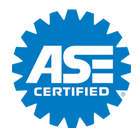SPRING STREET AUTOMOTIVE
Archive for October 2023The Need for Speed (Wheel Speed Sensor Maintenance)Posted October 29, 2023 8:37 AMToday's vehicles have some pretty amazing technology in them, including a computerized braking system we all pretty much take for granted these days. Antilock brake systems (ABS) have been around for years but they help drivers stop in much shorter distances reliably than ever before. When you see your ABS warning light come on, it's important to find out what's causing the problem. It's a safety issue. Often the problem when the ABS light comes on is a faulty wheel speed sensor. (In some cases the traction control light will also come on, perhaps because of a non-working wheel speed sensor.) Your vehicle uses the speed sensors to measure the rotational speed at each wheel. That sensor sends the speed data to a computer that can then adjust braking power and prevent your wheels from locking up. If any of the wheel speed sensors isn't working right, the ABS warning light will go on and the vehicle's computer will turn off the antilock brake system. You'll still have working brakes, but you will lose the functionality of that computerized system. When your vehicle warns you the ABS has a non-working sensor, you can have a technician check to see what's going on. It could be one of the sensors is dirty and a cleaning will solve the problem. But it also could be that one or more sensors needs to be replaced. A technician will use computerized diagnostic equipment to determine what and where the problem is, replace any bad parts and then check to make sure the system is fully operational. Antilock brakes and traction control are significant technologies that help prevent your vehicle from slipping on less-than-perfect road surfaces, especially useful during wintery weather. Make sure they're helping you drive the way they designed to. Spring Street Automotive Inc Straight Ahead (Wheel Alignment)Posted October 22, 2023 1:16 AMIf every road was straight and smooth, we wouldn't have to worry much about wheel alignment. But they're not, so we do. Hitting potholes or driving on rough pavement can knock your vehicle out of alignment and you'll notice it in one of several ways. Your steering wheel may not be centered when you're driving straight ahead, or your vehicle may pull to one side. You may find your tires wearing on one side or they may squeal. All are signs that could point to you needing an alignment. Your wheels should be perpendicular to the road and parallel with each other. If not, your tires will wear out faster and your vehicle won't go straight on a level straightaway. In alignment, there are several factors that must be checked. One is camber. Your wheels should be straight up and down if you look at them from the front. If not, you'll wear your tires unevenly on one side. Another factor is caster, the angle of the steering pivot. Most vehicles have what's called positive caster, when the top of the steering pivot leans toward the rear. Proper caster balances steering effort, stability on the highway and cornering. You may have heard the term "toe" in reference to your wheels. If you looked at your front wheels from straight above, for example, imagine your wheels were your feet. If you were to turn your toes in toward each other, that would be toeing in. The toe of your vehicle should be set to manufacturer's specifications so your vehicle handles well and doesn't prematurely wear out tires. It's a good idea to have your alignment checked periodically since it can get knocked out by one hard knock or a lot of little knocks. It's not just about tire wear, it's about ride comfort and safe handling. You may say a vehicle aligned just feels divine.
Giving CV Joints the Boot! (CV Joint and Boot Replacement)Posted October 15, 2023 4:38 AMEver wonder how your vehicle’s transmission is connected to your wheels? After all, when you hit a pothole or some other uneven part of a road’s surface, there has to be something that can maintain the connection between the transmission and the wheel yet keep everything moving at the same speed. That very cool device is called a CV joint, a kind of driveshaft running to each wheel. The CV stands for constant velocity because it keeps the drive wheels moving at a constant speed (velocity). They’re used mostly on front-wheel drive vehicles but also in rear-wheel and all-wheel drive vehicles. The joints move up and down and adjust to bumpy surfaces. Plus, they are covered in a rubber boot which protects them from road debris and also holds lubrication in. There’s a CV joint and boot on the transmission side and one on the wheel side. Unfortunately, the spot that usually fails first is that rubber protective cover (the boot). After a lot of wear, tear, bumps, road hazards, heat, and you name it, the rubber rips and the lubrication leaks out. At that point, it must be replaced. Here are signs to tell if your CV joint is bad.
Sometimes if a broken boot early is caught early, a technician can pack in new grease and replace just the boot. But if the lubrication has leaked out and the joint is already wearing badly, the CV and boot both have to be replaced. Give your vehicle the boot (as in a new boot) and CV joint, and you’ll be back on the road to your next destination. Spring Street Automotive Inc How Much is Enough for Quincy Auto Owners? Tire Tread DepthPosted October 8, 2023 12:46 PMMost Quincy drivers know that tires wear out and that the wear has to do with tread depth. Most of us have heard that “bald” tires are dangerous, but most of us picture a tire with no tread at all when we think of a bald tire. And when we take our vehicles in for preventive maintenance, the technician tells us they're need to be replaced long before all the tread is worn off. Just how much tire tread wear is too much? And how can you tell? Tires are and their condition is important to the safe handling of a vehicle, so it's for Quincy vehicle owners to know the answers to these questions. Spring Street Automotive Inc Clean Slate (Protecting Vehicle's Finish)Posted October 1, 2023 9:46 AMWinter is one of the hardest times to keep your vehicle clean. But did you know neglecting to wash your vehicle in winter could cost you a significant amount of money in the long run? Here's why. Many areas deal with snow and ice in the winter, and the salt and sand that are used to keep the road surfaces from being slick are also super corrosive to a vehicle's metal body and undercarriage. That includes all the parts underneath that can be splashed with brine, saltwater and other road debris. Winter is also tough on vehicles where there isn’t snow, sometimes from ocean salt or winter's extra humidity and rain. If you have any breaks in your vehicle's paint, whether it be from a little fender bender or a stone chip, that corrosive winter moisture can get through those cracks and start eating away at the metal underneath. If you can, you should get any dents or damage fixed as soon as possible so your vehicle has a protective layer of paint between road chemicals and the metal. You may want to wait until the warmer weather, but while you're waiting, the damage is getting worse. If you're not sure of a reputable body repair shop, check with the service advisor where you have mechanical work done. They're usually knowledgeable about who is good and not so good. You also may be tempted to skip the car wash during the winter since your vehicle is just going to get dirty fast anyway. You may want to reconsider. Many winter road treatments now use brine that gets in every nook and cranny of your vehicle. It's wise to clean that off regularly during the winter, and many washing facilities include a spray underneath that gets rid of that salt. Your vehicle repair facility may even have its own car wash, a nice bonus when you take your vehicle in for repair or regular maintenance. Spring Street Automotive Inc | ||
SearchArchiveJune 2015 (3)July 2015 (1) September 2015 (2) October 2015 (5) November 2015 (3) December 2015 (3) February 2016 (2) March 2016 (4) April 2016 (4) May 2016 (5) June 2016 (4) July 2016 (4) August 2016 (5) September 2016 (4) October 2016 (4) November 2016 (5) December 2016 (4) January 2017 (5) February 2017 (4) March 2017 (4) April 2017 (3) May 2017 (5) June 2017 (4) July 2017 (5) August 2017 (3) September 2017 (3) October 2017 (4) November 2017 (5) December 2017 (3) January 2018 (5) February 2018 (4) March 2018 (4) April 2018 (5) May 2018 (4) June 2018 (4) July 2018 (5) August 2018 (4) September 2018 (5) October 2018 (4) November 2018 (4) December 2018 (5) January 2019 (5) February 2019 (3) March 2019 (5) April 2019 (4) May 2019 (4) June 2019 (5) July 2019 (4) August 2019 (4) September 2019 (5) October 2019 (4) November 2019 (4) December 2019 (5) January 2020 (5) February 2020 (4) March 2020 (5) April 2020 (4) May 2020 (5) June 2020 (4) July 2020 (4) August 2020 (5) September 2020 (4) October 2020 (4) November 2020 (5) December 2020 (4) January 2021 (6) February 2021 (4) March 2021 (4) April 2021 (4) May 2021 (5) June 2021 (4) July 2021 (4) August 2021 (5) September 2021 (4) October 2021 (5) November 2021 (4) December 2021 (4) January 2022 (6) February 2022 (4) March 2022 (4) April 2022 (4) May 2022 (5) June 2022 (4) July 2022 (5) August 2022 (4) September 2022 (4) October 2022 (5) November 2022 (4) December 2022 (4) January 2023 (5) February 2023 (4) March 2023 (4) April 2023 (5) May 2023 (4) June 2023 (4) July 2023 (5) August 2023 (4) September 2023 (4) October 2023 (5) November 2023 (4) December 2023 (5) January 2024 (5) February 2024 (4) March 2024 (5) April 2024 (3) | CategoriesMaintenance (46)Automotive News (8)Shocks & Struts (8)Tires and Wheels (33)Windshield Wipers (9)Battery (13)Air Conditioning (10)Serpentine Belt (5)Alignment (15)Brakes (17)Cooling System (16)Safety (5)Cabin Air Filter (6)Service Standards (11)Fuel System (39)Fluids (14)Fuel Economy (6)Older Vehicles (4)Service Intervals (9)Exhaust (8)Fuel Saving Tip: Slow Down (1)Transmission (8)Headlamps (4)Steering (8)Timing Belt (5)Diagnostics (5)Parts (7)Keys to a long lasting vehicle (4)Drive Train (8)Inspection (6)Monitoring System (3)Trip Inspection (2)Auto Safety (5)Check Engine Light (4)Winter Prep (3)Engine Air Filter (2)Alternator (4)Suspension (3)Dashboard (2)Warranty (1)Oil Change (6)What Customers Should Know (50)Wheel Bearings (1)Differential Service (3)Tire Rotation and Balancing (2)Safe Driving (1)Emergency Items (1)Tires (5)Diesel Maintenance (1)TPMS (2)Winter Tires (1)Customer Detective Work (1)PCV Valve (2) | |












